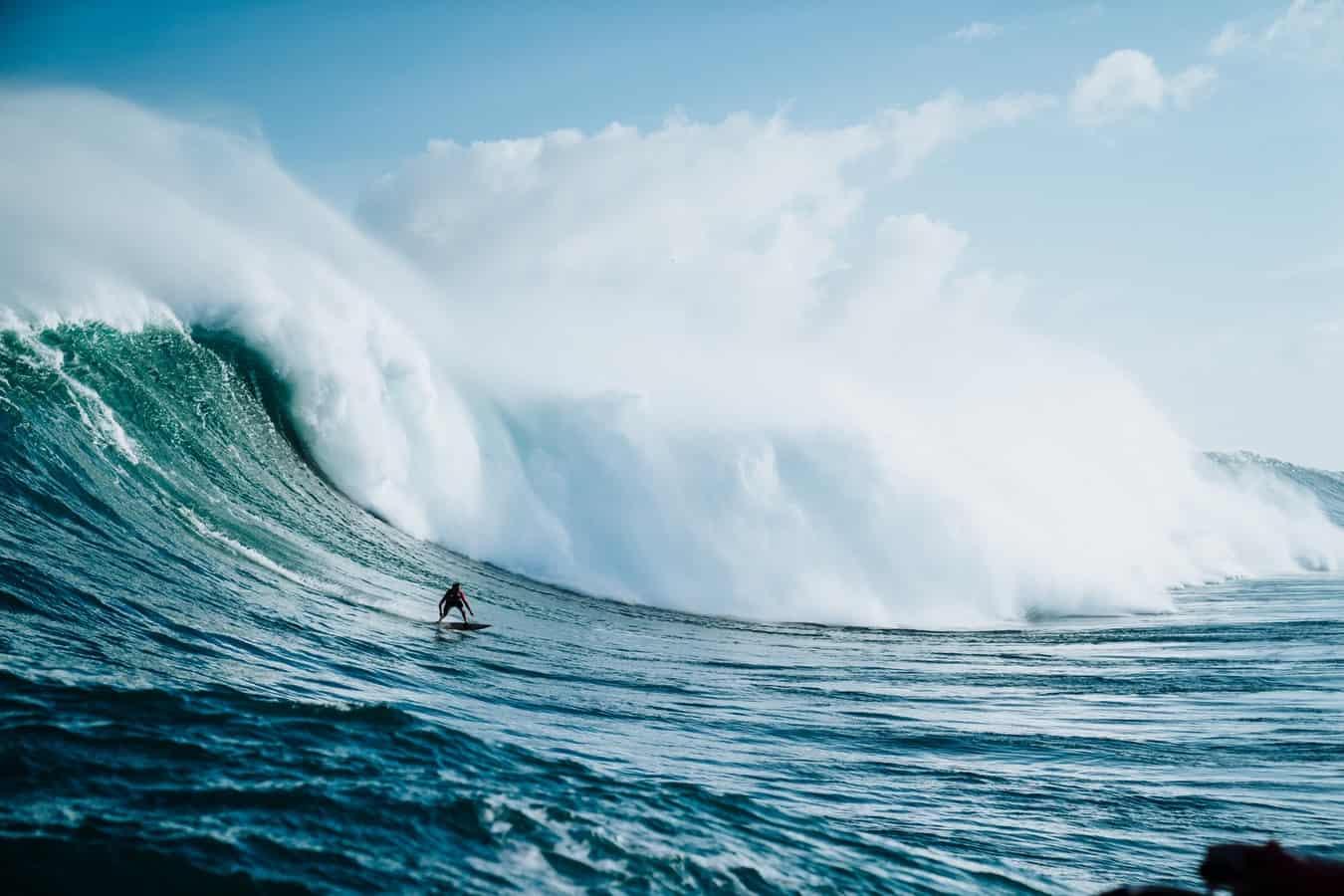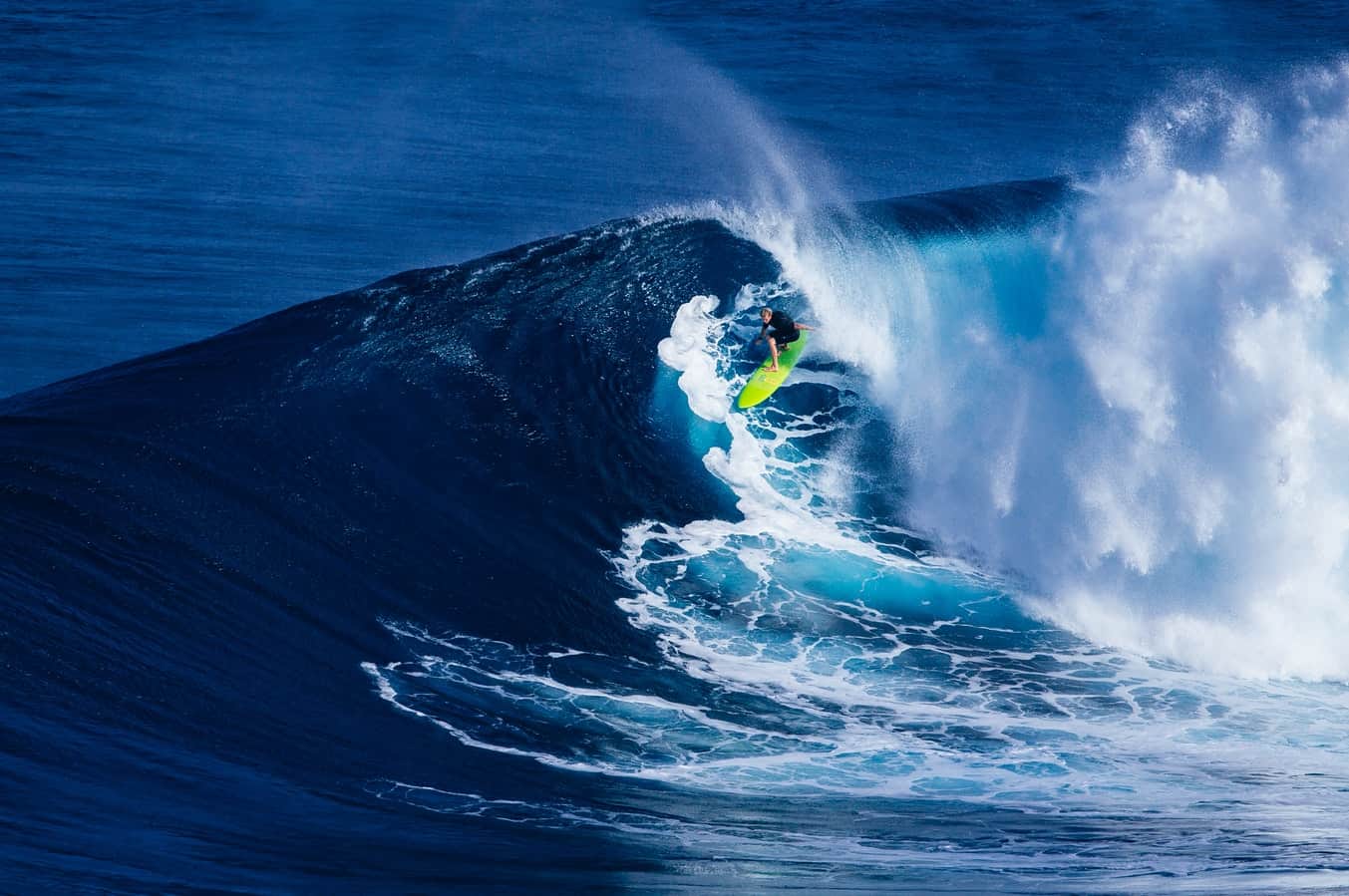Sure, going to the beach is nice. So is swimming and paddling out in the water. But if you love to surf, chances are you have a need for speed. But just how much speed are was talking here?
So how fast do surfboards go? Surfers can go as fast as 40 to 50 miles per hour on massive waves, but typically hit speeds of 10 to 15 miles per hour on the average 4 to 7 foot wave. On waves that are larger than 7 feet it’s possible to have a surfer get to a speed in the 20 MPH range.
How Does A Surfboard Generate Speed?
So how does your surfboard generate speed from the wave? Basically while some of the water flows up the wave, some will wrap around the inside rail and hold the board in the wave face. The rest will hits the bottom of your surfboard, and is directed along the length of your surfboard to exit out through the tail. Newton’s Third Law of Motion dictates that “every action has an equal and opposite reaction”, so when we re-direct that Effective Flow, your surfboard is acting as a hydrodynamic foil to create lift and forwards thrust. For every liter of water a surfer re-directs, they get around 2 pounds of lift and thrust, causing them to travel faster across the face of the wave.
Concave or channeled bottom contours are designed to redirect as much water as possible along the board and out past the fins. Convex or more circular bottoms shed water out towards the rails and are slower down the line, but facilitate easier turning as they transition from rail to rail more readily. The importance of generating speed from redirecting as much flow as possible along the length of your surfboard is why locking in your inside rail and taking a high line is why it’s such an important habit to form.
How Does A Surfboard Work?
So how does your surfboard work anyway? Most surfers simply accept the fact that you paddle into a wave, stand up and ride it, without every really questioning what’s making this happen, or what’s going on beneath our feet. When you shop for a new surfboard, you might think about variables like length, width, volume, bottom contours or tail-shape, but for the most part, the majority of us are blissfully ignorant to how exactly surfboards generate speed.
A big reason for this is the lack of proper research that has been done on surfboards. A lot of what we “know” about surfboards has been worked out through trial and error. While a few people have hypothesized the science behind why a board performs the way it does, most of the knowledge is carried by word of mouth and reputation rather than claims that have been supported with hard evidence.

Let’s start with the speed you experience when surfing. Where does that speed come from and how do we generate more? If your thought was gravity, you’re partly correct. When you paddle into a wave and drop down the face of it, it is gravity that’s pulling you down and causing you to accelerate and even when you angle across the wave, gravity is still helping to generate some of your speed. That’s why you can even feel like you’re in free fall for a brief moment when you drop into a significantly large wave. However, if gravity was the sole factor in generating speed, you would go fastest when going straight into the beach. But this is not the case. Your board actually travels far faster when travelling in trim across the face of a wave. This has to do with how the flow of water on the wave face interacts with your surfboard.
Where Does Wave Speed Come From?
When we look at an unbroken wave, it is mostly wave energy that’s moving, not the water. If you placed a rubber duck on the surface of the ocean and watched a wave pass, the rubber duck would rise and fall as the wave passed underneath. It wouldn’t be picked up and carried by the wave. A good way to think of it is to imagine rolling a bowling ball under some tarp. You would see the “wave” of the bowling ball moving under the tarp but the actual tarp itself remains in the same place. However, if we were to follow the bowling ball with a camera, we would see the canvas rushing past. The same is true if you travel with a wave in the ocean. This creates what we call an “Effective Flow” of water running up the face from the perspective of the surfer.
When we take off on a wave and set our rail to start riding across the face, our surfboard interrupts that apparent flow of water. Two things then happen: Our surfboard grips the face of the wave, and the surfboard generates lift and forward thrust. Depending on exactly how the board interacts with the water flow, the amount of lift, thrust and grip can be varied to suit the maneuvers a surfer is trying to do on the wave.
How Does A Surfboard “Grip” The Wave?
A surfboard can grip the wave because when some of the water moving up the wave face hits the bottom of the surfboard, it flows around the soft inside rail of the board. In the vast majority of cases, this is what holds your board into the wave, as opposed to your fins.
As far as physics is concerned, water is actually very sticky, so when it flows along a surface it will follow the curves. This attraction is what gives the board grip. A great example of this is to hold a spoon under a running faucet. If you hold it upside down the water flows along the curved surface and actually sucks the spoon into the water flow.
This holding power and the point at which water releases from a curved surface rather than gripping, can be predicted by a calculation called the Reynolds Number, a dimensionless quantity that is used to predict flow patterns in fluid mechanics. In the case of the rail of a surfboard in water, the speed of the water and the radius of the curve can be used to calculate the point at which the flow of water will release from the curve, with faster flow and tighter radius’ causing earlier release. This means that thicker, softer rails riding on smaller, slower waves will have much more hold in the wave face than a thin rail at high speeds.
What’s The Best Way To Get Speed From A Wave?
The most efficient way to surf a wave is with a gentle “roller coaster” ride up and down the face of the wave. However in order to make this work, you must master the timing and technique of the bottom turn. The next best route is to angle your takeoff and take a high line along the wave. This is easier to learn, and will give an intermediate surfer more time on the open face of the wave to practice their turns. The low route, whilst appealing during the early days of your surfing journey, is going to slow you down, both on that wave itself and in terms of your overall progression as a surfer.
How Do I Get More Speed On A Wave?
Generating speed on a wave takes time and a lot of practice. There’s nothing worse than seeing a surfer flailing around on a wave, desperately trying to go faster. You want to generate speed smoothly. Generally speaking, there are two types of speed generation, riding waves that have power, and waves that are flat.
With waves that have power, you mainly want to focus on using the wave’s power, to carve from on the wave from top to bottom. Staying close to the wave’s power is key, so you can always keep your speed up. One of the most overlooked aspects of surfing is paddling and wave positioning. If you are able to take off early at the peak of the wave, or even behind the peak of the wave, you are going to be moving a lot faster then if you take off too late in the lip, or too far out on the shoulder of the wave. The faster you paddle into the wave, also makes a big difference, as you can have a huge head start with a lot of board speed before you even stand up. Watch the best surfers at your local spot. They will mostly likely be sitting in the best position, and standing up with a lot of speed.
For flat or powerless waves, you need to generate your own speed. You want to move your board side to side quickly, using your thighs and upper body movement to generate speed. Focus on your body movement generating speed, and try to keep your style in mind, as these movements tend to expose style weaknesses very fast. Once you get more advanced, you can easily generate speed on a flat section of a wave.
What Is Pumping And How Do I Do It?
“Pumping” refers to act of surfing up and down the face of the wave in a smooth flowing motion. Surfers use this technique to reposition themselves in the top part of the wave pocket and use the wave’s power to get propelled forward.
The speed pump is accomplished by pushing down on your back foot so that the board climbs up the face of the wave. While pushing down on your back foot, lift your body up at the knees, unweighting the board. This unweighting causes the board to climb up the wave more quickly. After that you shift your weight back to the front side of the board, compressing your body, and navigating the board back down the face of the wave. You then repeat. One key thing that to keep in mind is that it’s absolutely crucial to have your backfoot in the right spot. Experienced surfers will instinctively move their foot if it’s in the wrong place. The more you surf, the more the proper footing will feel natural.
Can I Practice Pumping On Land?
Believe it or not, practicing carving on a longboard skateboard is a great way to develop your muscle memory for pumping. Practice on a flat, smooth street and picture one side of the road as the lip, and the other side the bottom of the wave. Do smooth bottom turns and top turns as far as you can, using your rails and body to keep your board speed up. The farther you can go down a flat road, the better you are getting at keeping speed through turns. Work on your style and body movements through these turns and you’ll be pumping like a pro on the water in no time at all! Happy surfing!

